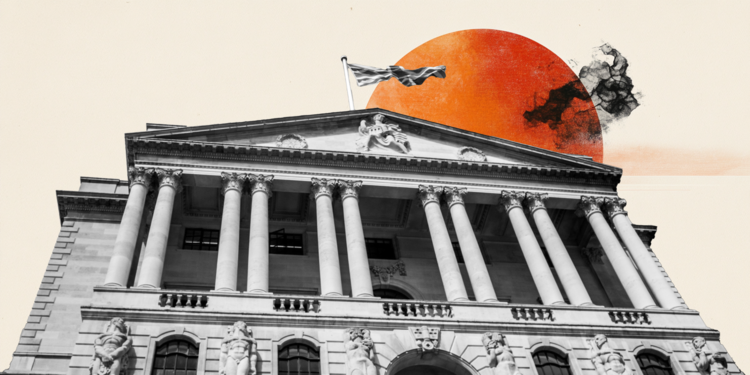Inflation in the UK reached its highest in more than a year as BoE’s decision looms

- The Bank of England is expected to trim the benchmark interest rate to 4.0%.
- UK inflation has unexpectedly surged, while economic growth has kept shrinking.
- GBP/USD battles to extend gains beyond 1.3300, may retest August lows in the 1.3140 area.
The Bank of England (BoE) is scheduled to announce its decision on monetary policy this Thursday, and market participants anticipate a 25-basis-point (bps) interest rate cut from the current 4.25% to 4.0%. Financial markets also anticipate seven out of nine Monetary Policy Committee (MPC) members will vote for an interest rate cut versus just three voting for such a decision in the previous meeting.
The announcement will be accompanied by the meeting Minutes and the Monetary Policy Report, a quarterly release that indicates officials’ economic analysis and the MPC inflation projections, which is the base of policymakers’ decisions.
Finally, Governor Andrew Bailey will offer a press conference, in which he will explain the reasoning behind the decision and maybe offer hints about what will come next on monetary policy.
United Kingdom economic outlook: why it matters
The Bank of England left the benchmark interest rate unchanged when it met in June. However, three MPC members cited “material further loosening in the labour market”, subdued consumer demand, and pay deals near sustainable rates as a reason to trim rates.
Since then, macroeconomic data has been quite worrisome. The Gross Domestic Product (GDP) contracted 0.1% MoM in May, following a 0.3% decline in April, according to the Office for National Statistics (ONS). The report also showed that “Of the three main sectors in May 2025, production output was the largest contributor to the monthly GDP fall, decreasing by 0.9%. Construction output also decreased by 0.6%. These figures were partially offset by an increase of 0.1% in services output in May 2025.” It is worth reminding ourselves that the first estimate of the second quarter GDP will be released on August 14.
Meanwhile, inflation in the United Kingdom (UK) has risen to its highest level in over a year in June. The Consumer Price Index (CPI) was up 3.6% on a yearly basis, after posting 3.4% YoY in May. Meanwhile, the core annual CPI printed at 3.7%, up from the 3.5% posted in May. The ONS indicated that food prices rose in June by the most since February 2024, while also indicating that services inflation remains at 4.7%.
Finally, employment-related data has been less worrisome as the labor market keeps loosening. The Unemployment Rate stood at 4.7% in April, increasing from the 4.4% posted at the beginning of the year.
BoE officials will have to assess whether slowing growth or rising inflationary pressures weigh more. Nevertheless, Governor Andrew Bailey said, “I really do believe the path is downward” on interest rates in an interview with the Times.
Regarding ecocoming projections, policymakers may upwardly review inflation perspectives and downwardly review growth-related ones.
How will the BoE interest rate decision impact GBP/USD?
The MPC has no easy task, and voting will likely be split. Generally speaking, market players anticipate an interest rate cut, which will be no surprise. The split vote among MPC members could shake the Sterling Pound, alongside discouraging revisions to growth and inflation. Market players will also pay close attention to Bailey’s words. The more hawkish despite the dismal macro picture, the less likely the GBP is to fall.
Ahead of the announcement, the GBP/USD pair trades within a tight range just above the 1.3300 mark, pressuring the upper end of the range with a modest upward bias. Still, the expected BoE announcement seems more of a downward risk for the pair.
Valeria Bednarik, FXStreet Chief Analyst, notes: “The GBP/USD pair hover around its weekly peak in the 1.3330 region, without any technical sign of additional gains ahead. The daily chart shows a flat 100 Simple Moving Average (SMA) provides resistance at around 1.3350, while the 20 SMA maintains its bearish slope at around 1.3400. The pair could turn bullish once beyond the latter, an unlikely scenario with the BoE’s expected announcement.”
Bednarik adds: “On the downside, the 1.3250 area is the one to watch, as once below it GBP/USD may turn bearish. Interim support comes at 1.3200 ahead of the August monthly low at 1.3141.”
Pound Sterling FAQs
The Pound Sterling (GBP) is the oldest currency in the world (886 AD) and the official currency of the United Kingdom. It is the fourth most traded unit for foreign exchange (FX) in the world, accounting for 12% of all transactions, averaging $630 billion a day, according to 2022 data.
Its key trading pairs are GBP/USD, also known as ‘Cable’, which accounts for 11% of FX, GBP/JPY, or the ‘Dragon’ as it is known by traders (3%), and EUR/GBP (2%). The Pound Sterling is issued by the Bank of England (BoE).
The single most important factor influencing the value of the Pound Sterling is monetary policy decided by the Bank of England. The BoE bases its decisions on whether it has achieved its primary goal of “price stability” – a steady inflation rate of around 2%. Its primary tool for achieving this is the adjustment of interest rates.
When inflation is too high, the BoE will try to rein it in by raising interest rates, making it more expensive for people and businesses to access credit. This is generally positive for GBP, as higher interest rates make the UK a more attractive place for global investors to park their money.
When inflation falls too low it is a sign economic growth is slowing. In this scenario, the BoE will consider lowering interest rates to cheapen credit so businesses will borrow more to invest in growth-generating projects.
Data releases gauge the health of the economy and can impact the value of the Pound Sterling. Indicators such as GDP, Manufacturing and Services PMIs, and employment can all influence the direction of the GBP.
A strong economy is good for Sterling. Not only does it attract more foreign investment but it may encourage the BoE to put up interest rates, which will directly strengthen GBP. Otherwise, if economic data is weak, the Pound Sterling is likely to fall.
Another significant data release for the Pound Sterling is the Trade Balance. This indicator measures the difference between what a country earns from its exports and what it spends on imports over a given period.
If a country produces highly sought-after exports, its currency will benefit purely from the extra demand created from foreign buyers seeking to purchase these goods. Therefore, a positive net Trade Balance strengthens a currency and vice versa for a negative balance.
Economic Indicator
BoE Monetary Policy Report
The Bank of England publishes a quarterly report which includes a detailed economic analysis on which the Bank’s Monetary Policy Committee (MPC) bases its interest rate decisions. More importantly, the report also presents an assessment of the prospects for UK inflation over the following two years. Elevated inflation projections are generally bullish for the Pound Sterling (GBP) as they imply higher interest rates. Likewise, low inflation expectations are bearish for GBP.
Read more.

